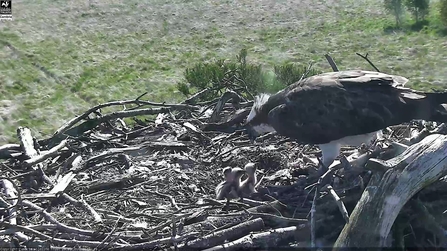
Osprey with chicks at Foulshaw Moss Nature Reserve, 29 May 2020
Gifting membership? Order by Wednesday 17 December in time for Christmas.

Osprey with chicks at Foulshaw Moss Nature Reserve, 29 May 2020
It’s been a long six weeks for Foulshaw osprey watchers. The first egg was laid on 17 April, the other two at roughly two day intervals after that. After 42 days of very patient incubation - mostly by mum but with dad doing his bit too - all three eggs hatched.
As the first hatching approached, mum became quite agitated, often turning her head down towards the egg. This was her listening to the chick inside the egg, “pipping” away to let her know it was on the way. On the evening of Sunday 24 May the first egg hatched. The chick forces its way out using an egg tooth, a hard little bump on the beak that it uses as a tiny hammer to break through the shell. Once the chick has used this handy attachment, it disappears not long after hatching.
Chick two joined us early on the morning of Tuesday 26 May, about 36 hours after the first. Then, on Friday 29, number three finally popped out. We decided to give them temporary names, Yan, Tan and Tethera, after the old Cumbrian shepherds’ system for counting sheep.
Then on Wednesday 3 June we were alert to the fact that sadly one chick either been predated or died and the adults had removed it from the nest. We are currently downloading the webcam to go through the footage to work out what may be the cause. Thankfully, the other two chicks appear to be healthy and feeding well.
The chicks need careful looking after. They are known as “semi-precocial”, as they are not as advanced at an early age as ducklings or chickens, who can scamper around after half a day, but further on than the young of songbirds, whose featherless chicks are born blind and helpless. Osprey chicks have a coat of down to keep them warm. This first coat is white, although they are born with the black “bandit mask” around their eyes. They can stand up soon after hatching, although this tends to be a bit of a wobbly balancing act. This is why they are affectionately known in osprey watching circles as “bobble heads.”
Parenting is a real double act. She stays with the chicks while he goes out to catch fish. These babies are not interested in milk or rusks. After five weeks of nothing but egg for breakfast, lunch and tea, they are hungry. She takes what he brings back and feeds the youngsters, giving them their first taste of raw fish within a few hours of hatching. It is extraordinary to watch this ferocious raptor, with her massive talons and razor-sharp beak, carefully tearing off tiny morsels and delicately passing them to the tiny bobble heads. She also moves around them with great care, turning her talons inwards and walking on her knuckles to avoid accidentally harming them.
The fish has to keep coming, because bobble heads grow fast. At hatching an osprey chick weighs just fifty grams, under two ounces. They triple that weight in the first eight days, then double it again in the next four. That’s even more weight than I’ve gained during lock down. By 30 days they reach 75% of their body mass, over a kilo. Dad will be kept busy with the takeaway deliveries as he not only has to feed these rapidly expanding youngsters, but himself and mum as well.
Mum is the only one who actually loses weight at this time as she is so busy keeping the brood fed that she doesn’t always manage to feed herself enough. It’s not the only sacrifice she has to make. She not only does the catering, she is also there to act as a feathery duvet to keep them warm, an umbrella to keep them dry and a sun shade to keep them cool.
Although we can’t be at the reserve at the moment, it’s been a joy to welcome them to the world and we will be watching the webcam carefully as they start their journey through life.